
In this article we cover one of the major Olympians, Athena, and one minor goddess, Nike, who is often associated with Athena. Athena has one major characteristic in common with Artemis: both are sworn to virginity and have absolutely no sexual relationships whatsoever. Thus, these two represent the sacred purity of young women before the age of marriage.
Included in this article is a thorough description of the Parthenon of Athens, probably the most well-known ancient Greek temple.
Contents
Athena (Minerva to the Romans) was the principal goddess of Athens, a city named for her as a result of the contest with Poseidon (seen in the Prometheus article). Although easily recognized as a warrior by her armor and weapons, she was not like the brutal, violent war god Ares. Athena was much more a goddess of strength and power with virtue. Indeed, one of her primary characteristics was her inviolable virginity. A recurrent theme in the stories involving Athena is justice, or the triumph of civilization over barbarism, as mentioned in the "Trojan War 2" sections on Oresteia and the Odyssey.
Here are a few basic representations of Athena. The first is a coin from classical Athens, with Athena's face on one side, and her symbolic bird, the wise owl, on the other.
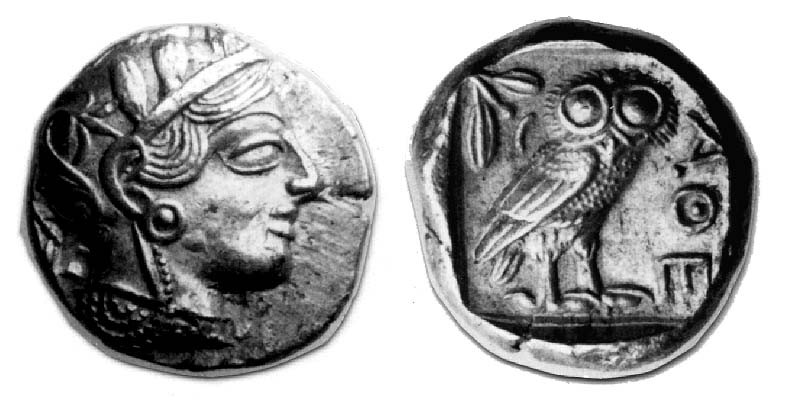
Athenian Coin
The second image is also from the classical period, a relief sculpture known as the "Mourning Athena," probably intended as a tombstone.

Mourning Athena
Next we have a red figure vase painting depicting Athena in the company of the great hero, Herakles, whose story is covered in the article on Herakles. Athena will be seen often advising the great heroes or assisting them in their great challenges.

Red Figure
Next is a Renaissance painting by Botticelli (1445-1510) showing Athena vanquishing a centaur. In the Aphrodite article we view several paintings by Botticelli featuring Aphrodite/Venus, but here he has used this goddess instead for the allegorical symbol, the message being the triumph of civilization over savagery.

Pallas and the Centaur, Botticelli (c. 1482)
The last painting is "Pallas Athene," a 19th Century work by Gustav Klimt (1862-1918).
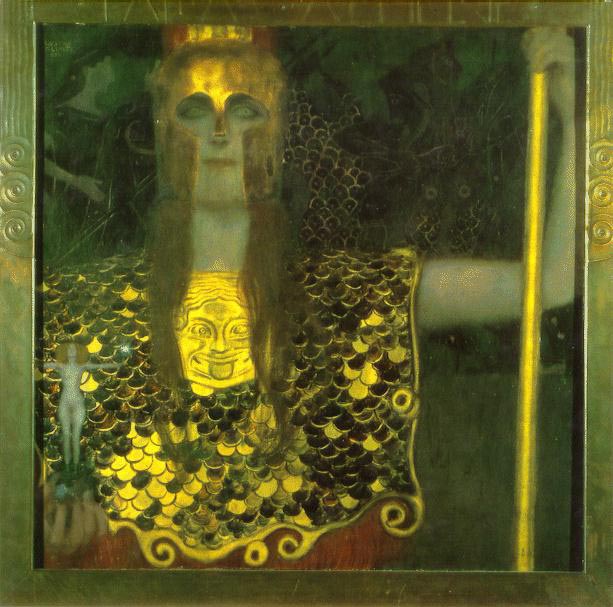
Klimt, Pallas Athene 1898
The first significant story of Athena is that of her unusual birth. Once again, the source for the story is Hesiod's Theogony, the same poem which told the story of Zeus' rise to power (covered in the Titans article).
Hesiod tells how Zeus' first mate was a goddess named Metis, who became pregnant. Then Zeus learned that the second child of Metis would be a son who would be stronger than his father, the one thing he had most to fear. His solution was to simply swallow Metis whole, similar to the way his father Cronus swallowed his own children. But later Zeus developed a headache so painful that he asked Hephaestus to use his axe to split open his head to relieve the pressure. When he did this, out sprang the goddess Athena, fully grown, wearing armor and carrying weapons.
In the four images below, we see this event. The first black-figure vase shows Zeus surrounded by other Olympians, Hermes and Apollo on the left, Ares and Aphrodite on the right.

Black Figure 1
The second black-figure vase, as well as the red-figure version below it, includes Hephaestus still holding his axe.

Black Figure 2

Red Figure
The final image is a modern 20th Century sculpture by Rudolf Tegner. See the section below on the Parthenon pediments for one more version of the birth of the goddess.

Zeus Giving Birth to Athena, Tegner
Not far from Athens is the island of Aegina, the location of a fairly well-preserved temple from the very beginning of the classical period (i.e., about 490-475 B.C.). The temple itself was dedicated to a minor local goddess named Aphaia, a character whose primary myth concerns the preservation of her virginity. It is clearly this characteristic which connects Aphaia to Athena, the virgin goddess, and would explain why Athena is the featured figure in the sculptural decorations of the pediments.
The first image below shows the temple as it is today (notice that there are six columns on the end, unlike the Parthenon which has eight).

Aegina Temple
The next image shows the fragments of the pedimental sculptures arranged as they were on the temple. One unusual discovery there was evidence of a third pediment group, apparently displayed at ground level, probably an earlier group which had been replaced but was kept.
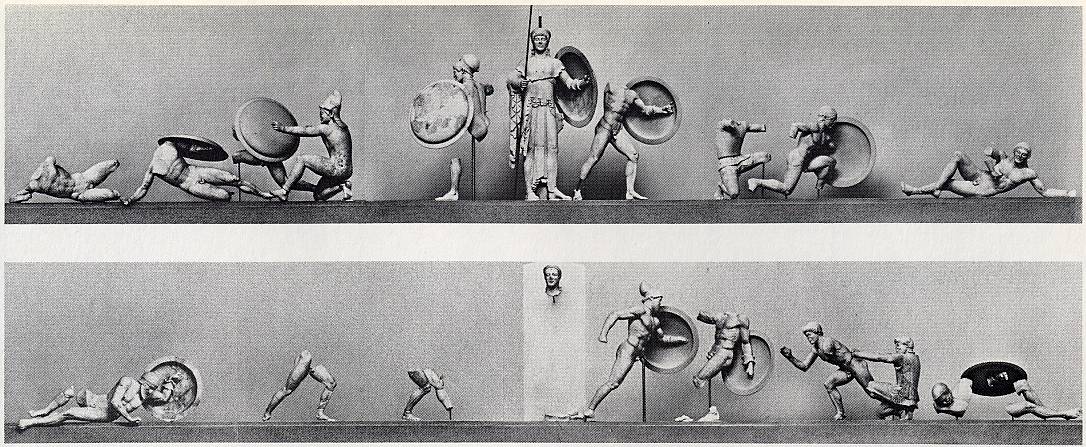
Aegina Pediments
The main figure in the east pediment is Athena, the only one able to stand fully erect in the triangular space available in a pediment. On either side of the goddess are soldiers fighting or falling. One is recognizable as the hero Herakles (Hercules), but it is not known which particular conflict this group depicts.

Athena
The closeup of Athena's face shows the "Archaic smile" typical of the previous century. Art historians classify this style as 'transitional' between the archaic and classical styles. Also noteworthy are the holes visible for bronze attachments added separately, but now missing.

Athena Head Closeup
Probably the most famous monument from ancient Greece, the Parthenon is the main temple of Athena in her city of Athens, located on a large hill known as the Acropolis. The first image below is an aerial photograph of the Acropolis, with the Parthenon near the center. To the lower left is the entrance to the Acropolis known as the Propylaea.

Acropolis - now
Next is a portion of a painting done by German architect Leo Von Klenze in 1846, a ground-level view with the buildings restored to their original appearance. Looming over the walls of the Acropolis on the left is the giant bronze statue of Athena known as the Athena Promachos ("foremost in battle"). Only a few fragments of its pedestal are visible today. This statue was also the work of Pheidias, the master sculptor who designed the decorations of the Parthenon itself, as discussed below.

Acropolis - then (von Klenze)
The third image is a current photograph of the west end of the Parthenon.

Parthenon - now
And a drawing by architect Gorham P. Stevens from 1938 showing the same perspective in a restored view.

Parthenon - then
Since the actual building is little more than a shell, with most of its decorations damaged or missing, perhaps the best way to grasp the appearance of the intact Parthenon is this view of the exact duplicate built in the 1920s in Nashville, Tennessee (although it is made of concrete, not marble like the real Parthenon).

Nashville Parthenon Replica (1920)
By the time modern archaeologists were able to document the remains of the Parthenon, the decorative sculptures of both pediments had suffered terrible damage. Many figures had been completely destroyed, and some existed only as small fragments. The first diagram below shows the total amount of original fragments still existing, on display at the British Museum ever since their acquisition by Lord Elgin in the early 1800s.

Pieces
As you can see, the western pediment has suffered a little less than the near-total destruction of the east pediment. Along with some drawings made in the 1600s when the west pediment was in better condition, it is possible to reconstruct this one with a fair degree of accuracy.
The view below of the Nashville west pediment also appears in the article on Prometheus, depicting the contest of Athena and Poseidon.

West Pediment
The east pediment, however, is a different story. This end of the building was demolished in the early Christian period when a church was constructed inside the remains of the Parthenon. Originally the east end of the building was the main entrance, and thus its pediment would be considered more significant than the west, the back end of the building. What we do know is that it depicted the birth of Athena, goddess of the Parthenon, but exactly how the figures were arranged is speculation. The model shown below is a conjectural restoration, which is now known to be inaccurate in several details.
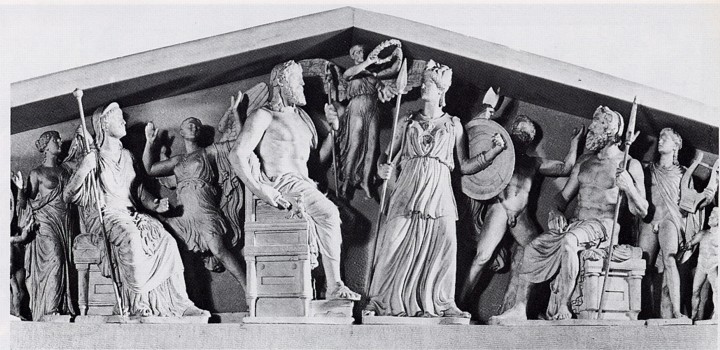
East Pediment: Old Version
The final image is a drawing based on the most recent architectural analysis (the markings on the base of the pediment, which provide clues to the arrangement). It seems that Zeus dominated the center position, with the newly-born Athena to the right. Even on her own temple, Athena has to take second place to Zeus.

East Pediment: Current Version
Another form of sculpted decoration on the Parthenon is known as the frieze, a term meaning a continuous horizontal relief. On the Parthenon, the frieze is elevated, at the level of the tops of the columns within the outer perimeter or colonnade. The first image below shows an imaginary bird's-eye view of the people participating in a ritual known as the Panathenaic procession in honor of their primary goddess Athena. Next is a modern photograph with a portion of the west frieze visible behind the outer columns and pediment.

Procession
The subject of the frieze is somewhat unusual in that it depicts mostly ordinary citizens. Dozens of figures, male and female, some on foot, some riding horses, some bearing offerings are seen forming a procession which begins at the west (back) end, moving along both long sides towards the central scene over the main (east) entrance. Here we see two of the many riders, and then a group of three Olympian gods watching the arrival of the people.

Horsemen

Gods
The next image shows, at the center, the eroded figures of an adult male and a young female folding a large cloth. Being the exact center, it must be a scene of extreme significance, but what exactly are they doing? The traditional explanation was the presentation of a sacred garment to Athena, but a recent theory may have hit upon the right answer. One of the most crucial myths of Athens told of the daughter of an early king who sacrificed her life to save the city—a story likely to be more meaningful to the Athenians. If so, we are actually seeing the preparation of her burial shroud.

Centerpiece
The final image is a romanticized painting by Lawrence Alma-Tadema, a very popular Dutch-English artist of the Victorian era. Here he has recreated a scene of the Parthenon frieze under construction. Pheidias, the master sculptor, is displaying his work to a group of visitors who have climbed a scaffold. Note how the frieze figures are painted in bright colors, which is a historically accurate detail.

Phidias Showing the Frieze of the Parthenon to his Friends, Alma-Tadema (1868)
Pheidias' ultimate masterpiece for the Parthenon was the colossal cult-image which stood inside the temple, known as the Athena Parthenos ("Athena the Virgin"). Standing about 30 feet tall, the statue was not only a great work of art, but extremely valuable just for its material, gold and ivory. Another colossal gold and ivory statue by Pheidias, the Zeus at Olympia, appears in the Prometheus article.
Many of the same difficulties regarding the giant Zeus apply to the Athena Parthenos as well. For example, the statue itself no longer exists, so we must rely on written descriptions by ancient visitors, or small-scale copies made when the original still existed, such as the Varvakeion statue seen below, from the Hellenistic or Roman period.
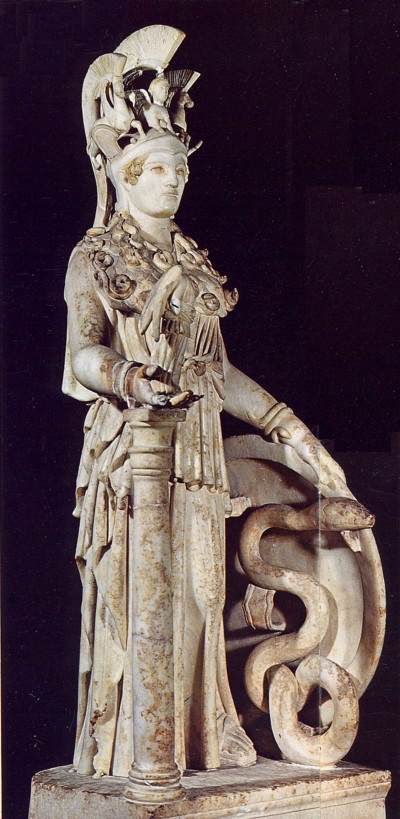
Varvakeion
Next is a romanticized restoration by Benoît-Édouard Loviot, a member of the Ecole des Beaux Artes in the late 1800s. Although he has taken some liberties with the details, it is nevertheless a very impressive painting.
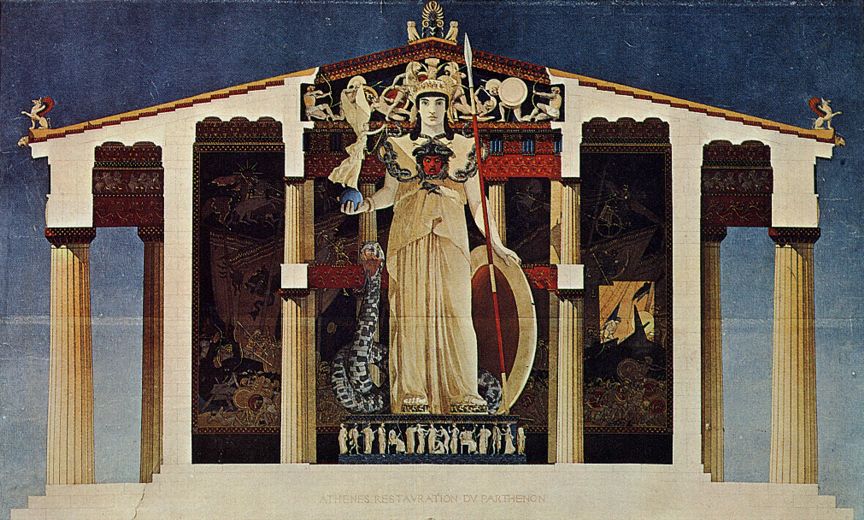
Parthenon - Cross section restored, Loviot
In the 1960s, the Royal Ontario Museum in Toronto sponsored a project to collect all existing data on the Parthenos, resulting in the closest possible appearance of the original. The model seen in the photograph is one-tenth scale, so it is about three feet tall.

Toronto
The Nashville Parthenon (described above) originally stood empty in the center, but in 1982 they added a replica of the Parthenos, by sculptor Alan LaQuire.

Nashville Parthenos 1982
Although the Nashville Parthenos at first appeared stiff and manikin-like, the finished version significantly improves the effect and properly conveys a sense of its size (42 feet, or 13 metres), something the smaller models cannot.
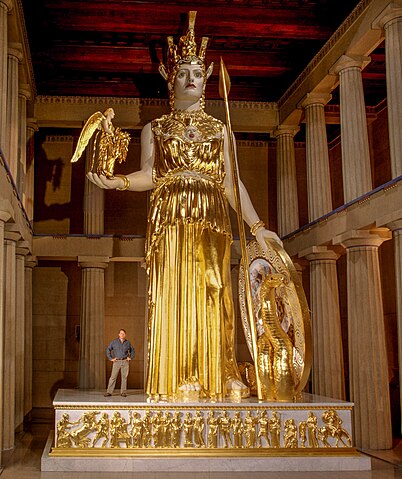
Nashville Parthenos painted and gilded
The ancient Greek original Athena Parthenos was formally dedicated in 438 B.C., establishing a terminal date for the construction of the building and its decorations.
One of the many stories involving Athena tells how she was the inventor of the flute. We see her below in the center of the first red-figure vase painting playing the instrument. But then the others around her began laughing and Athena wondered what they found amusing. They told her that she looked silly when she played it, with her cheeks puffed out. Athena was angered at this mocking, so she threw the flute to the ground in disgust. This was witnessed by the satyr named Marsyas, who eagerly snatched up the instrument the goddess had thrown down.

Red Figure 1
The second red-figure vase painting shows the pair, with Marsyas seen just before he picks it up.

Red Figure 2
This scene was the subject of a famous Classical sculpture by an artist named Myron of Eleutherae. His career is contemporary with Pheidias (both active around 440 B.C.), and this masterpiece was displayed on the Acropolis. As in other Classical works, we no longer have the original work, but we do have copies, or portions of copies, made in Hellenistic and Roman times.
The next photograph shows the fragments of both figures in the Vatican collection.

Athena and Marsyas sculpture fragment s, Vatican
Although Athena's head is missing from the above copy, a different copy has the head, seen in this photograph.

Athena
Combining all the available evidence, it is possible to recreate the original composition, seen here in two versions, one black and white, one in color. Note that the original was in bronze, but the copies were made of marble.

Replica 1

Replica 2
The final image has nothing to do with mythology, but it is one of the most famous sculptures from ancient Greece, the Discus-thrower, which was also by the Classic sculptor Myron of Eleutherae.

Discobolus, Myron c. 450 BC
One of the minor goddesses was Nike, a name which means "Victory" in Greek. Nike is frequently seen associated with Athena. In the images above depicting the Athena Parthenos, a small figure of Nike can be seen standing in her hand. (It only looks small in comparison to the colossal Athena. Actually, it would have been about life-size).
As seen also in our study of the Titans, the temple of Zeus at Olympia was one of the most famous sites of the Greek world, and this next sculpture was discovered near it in the late 1800s, an independent, free-standing figure which stood near the main temple building. Our information on this statue is primarily from a written description by the author Pausanias (2nd c. A.D.), as well as the inscription from the base of the statue, which still exists.
This inscription states that this Victory, made by Paeonios, was commissioned by the Messenians and Naupactans to commemorate their defeat of the Spartans in 424 B.C., putting an approximate date on the work, just a few decades after the Parthenon sculptures.
The image below shows the actual remaining fragments, along with a conjectural restoration based on other sculptures from the same time period. The figure of Nike is seen hovering with wings spread, the subtle details of the drapery enhancing the effect of a human figure in flight.

Paeonios Nike
The Nike was mounted on a triangular pedestal which tapered towards the top, seen in the diagram below.

Pedestal
This magnificent sculpture was discovered in 1862 at Samothrace, a coastal city in the northern Aegean. The name of the sculptor and its exact date are unknown, but stylistically, it fits into the same time frame as the Altar of Pergamum, that is, approximately 180-150 B.C.
It was certainly intended as the previous figure was, a monument to commemorate a military victory, most likely a naval battle, which would explain the context of the figure, as seen in the second image. The Victory was placed on a pedestal shaped like the prow of a ship. She is leaning into the wind as the ship seems to move forward.

Samothrace Nike 1

Samothrace Nike 2
Now on display in the Louvre in Paris, the Winged Victory is a powerful work of art, even as damaged as it is. The flowing lines of her garment display an energy, a vitality that ranks among the finest works of the Hellenistic period. There are some small similar representations of Nike on coins which suggest that she may have been blowing a trumpet and/or bearing a victory wreath.
The images below show the same side view, but the black and white version has some better detail than the color photograph.

Nike 3
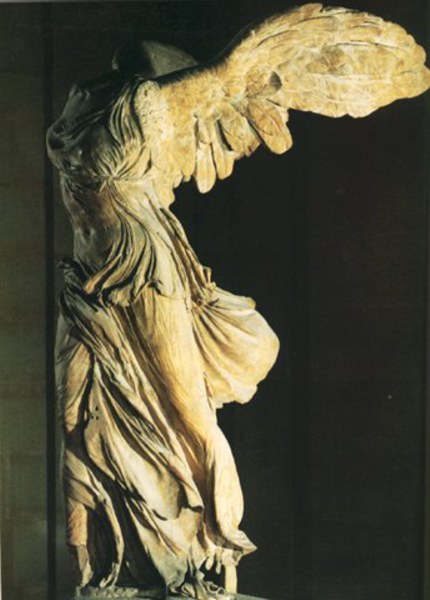
Nike 4